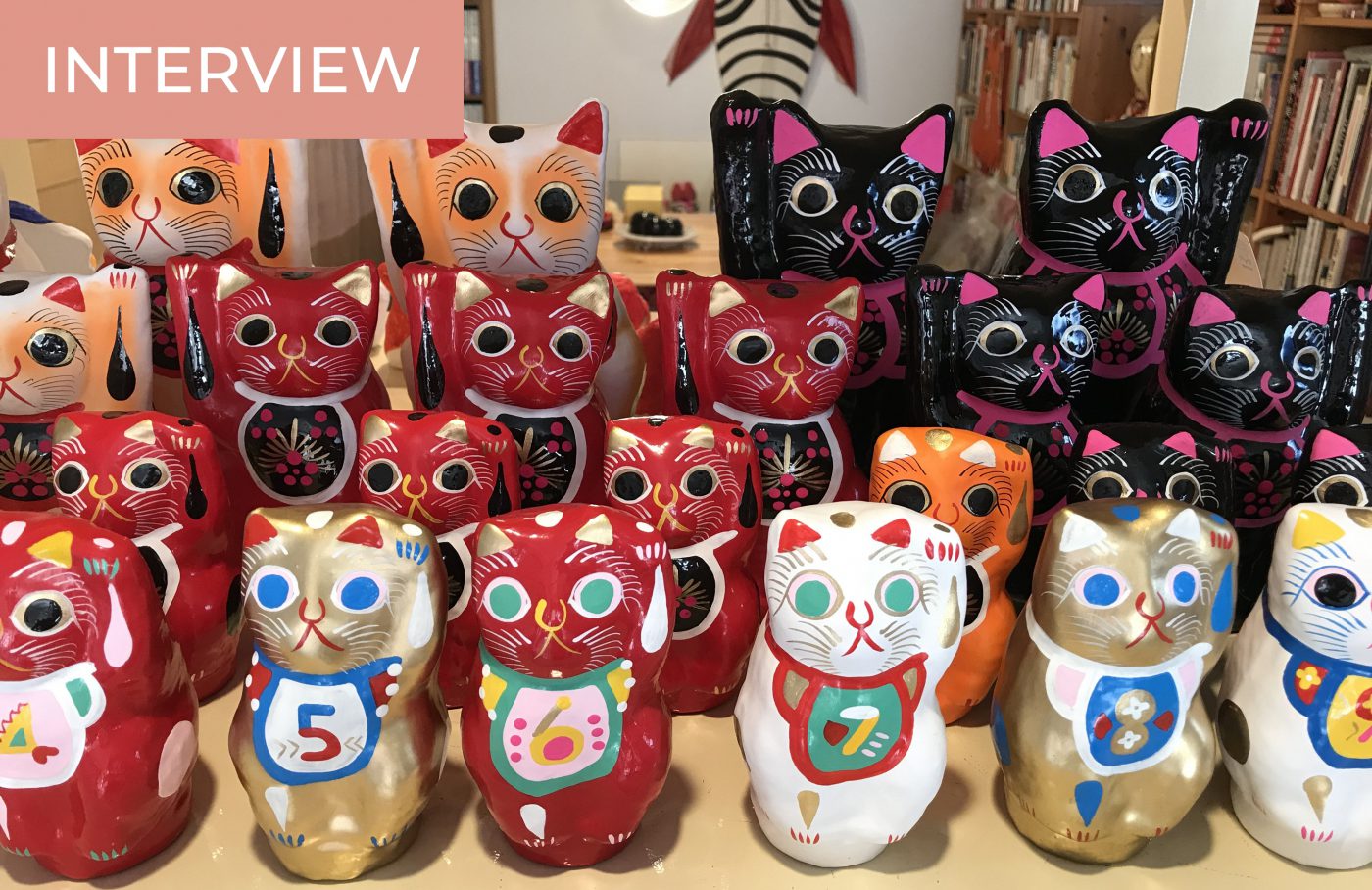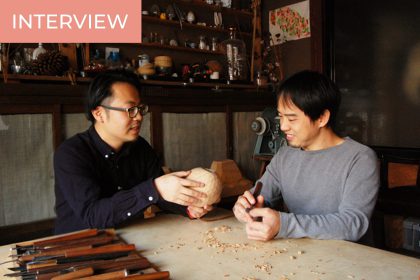Mrs. Iijima and Mr. Usuda are co-heads of Atelier Taik, a design company that does all kinds of design work with the exception of architecture. They are passionate about their jobs and often become fans of their clients’ products or services in the process.
In 2012, they opened Atelier Gangu, a small shop selling and introducing folkcraft toys handmade by artisans from all over Japan. I have visited them to learn more about these toys, and I did not expect that they would have such a deeper, spiritual meaning.
What Is Gangu?
In 2012, you opened “Atelier Gangu,” a shop that sells gangu, on your studio’s first floor. Could you please tell us what a gangu is?
Mr. Usuda: When we had to translate it, it was complicated. In English, we refer to it as a “folkcraft toy,” but it’s not exactly a toy.
The gangu’s origins are not clear historically. People started collecting what they called “kyodo gangu” [“folk toy”] during the Edo period [1603–1868]. Still, it’s rather that the word was born to qualify something that already existed. Gangu have diverse origins: some are toys parents would give their children, some were lucky charms people brought to the shrines to pray, some reflected the local habits, conventions or annual celebrations.
Mrs. Iijima: They appeared spontaneously.
Mr. Usuda: In Japan, there is a “Folk Toy Association.” Its members love to collect gangu and are almost all male.
Mrs. Iijima: Japanese children indeed used to play with gangu. But after plastic appeared and new sorts of toys could be made in large quantities, gangu stopped being for children and started to be an adults’ hobby. We don’t aim at reaching these collectors. We’re more about making people discover the charms of the gangu through their colors, characters, and story.
By the way, we don’t call our gangu “kyodo gangu” [“folk toy”] because “kyodo” can be translated just as “local.” We prefer the term “mingei gangu” [“folkcraft toy”]. In Japanese, the kanji characters for the word “mingei” [民芸] are written as “people” and “art.” We use this term to emphasize the work of the artisans and their sense of beauty.
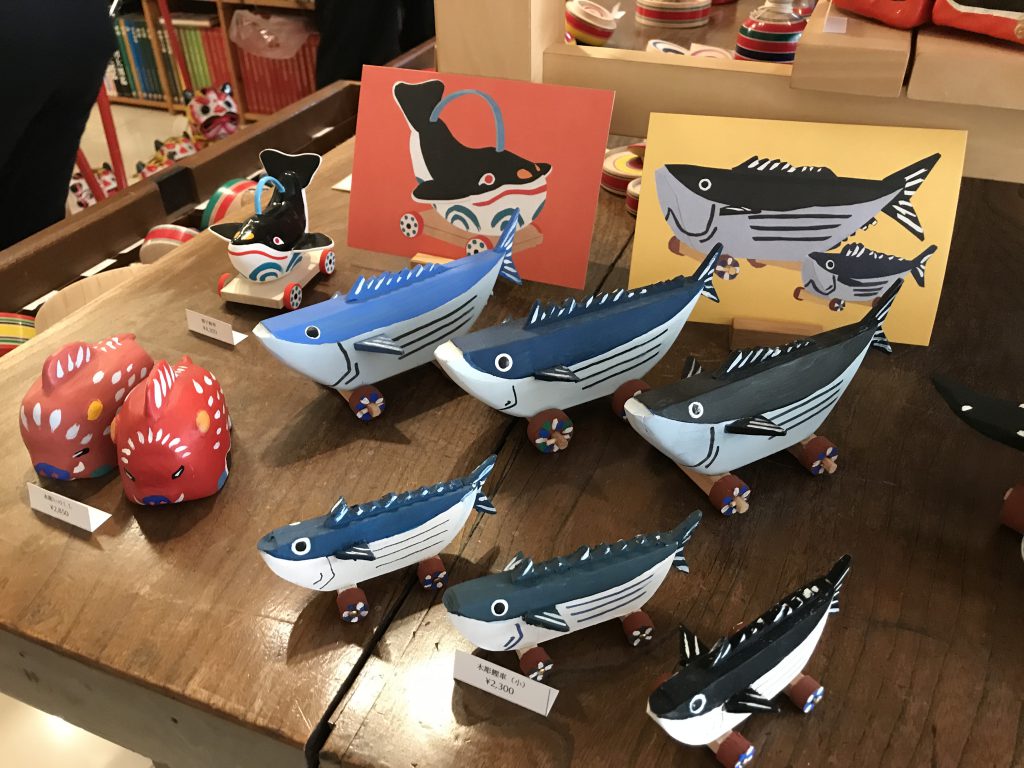
Mr. Usuda: We have a lot of foreign customers, mainly Europeans. They often ask me, “What is this object? What was its original meaning?” Then, I can explain that it was to pray for the rice fields, or that it was to have an easy delivery of a baby, or to keep diseases away, etc. It’s very easy for me to explain the role of each toy, but it’s hard to define what “gangu” is as a general genre. The folkcraft toys come from all areas, and all have a different origin. Some of them, such as tigers or Daruma dolls, even originally come from China.

Gangu may have been used to keep diseases away from children and allow them to grow up safely.
The researcher Shizuka Shirakawa, in his book “Jito” gives some clues about the kanji for gangu [玩具]. He says that the first character means “making someone healthier by making them wear a magic object”. He also explains that the second character derives from the character that means “seashell” [貝], and that there used to be a custom of making girls wear cowrie shells as magic objects.
Mrs. Iijima: Also, gangu are painted with gofun, a traditional white pigment made from seashells.So maybe this was some sort of magical custom. In older times, children would die from all kinds of illnesses. The folkcraft toys may have been used to keep diseases away from children and allow them to grow up safely.
The Hidden Powers of “Lovable Non- Essential Goods”
At the very origin of this shop, there’s a story involving a black cat.
Why did you decide to open Atelier Gangu back in 2012?
Mr. Usuda: Because ofthe 2011 Great East Japan Earthquake’s aftermath. But to tell the truth, at the very origin, there’s a story involving a black cat.
One day, someone offered me a manekineko [lucky cat], and I put it at our office entrance. After that, our number of jobs suddenly increased, so much so that we could move to a new office [laughs]! Later, I put the lucky cat on the veranda, facing the window. And every evening, we would see a black cat entering the garden, who came to meet our manekineko and just sit there looking at it [laughs]. We were all very intrigued, and I got a spiritual specialist to look at the manekineko. They advised me to make another one, a black one with its left paw raised and put it near the office phone.
However, I had never seen a black manekineko anywhere, so I figured I had to order one. I browsed the yellow pages and called a Daruma doll maker in Takasaki City, who, in turn, gave me the number of a manekineko maker. They told me they could make one, and I would just have to say a size between five and 70 centimeters. So, I asked for a 15-centimeter one. And it worked! Hearing this story, people around me all started to want one. I had a bigger cat made in the hope of having “bigger” jobs, and we got a 60-centimeter tall manekineko [laughs]. I put it next to the phone, and the very next day, we got a call for a huge job [laughs].
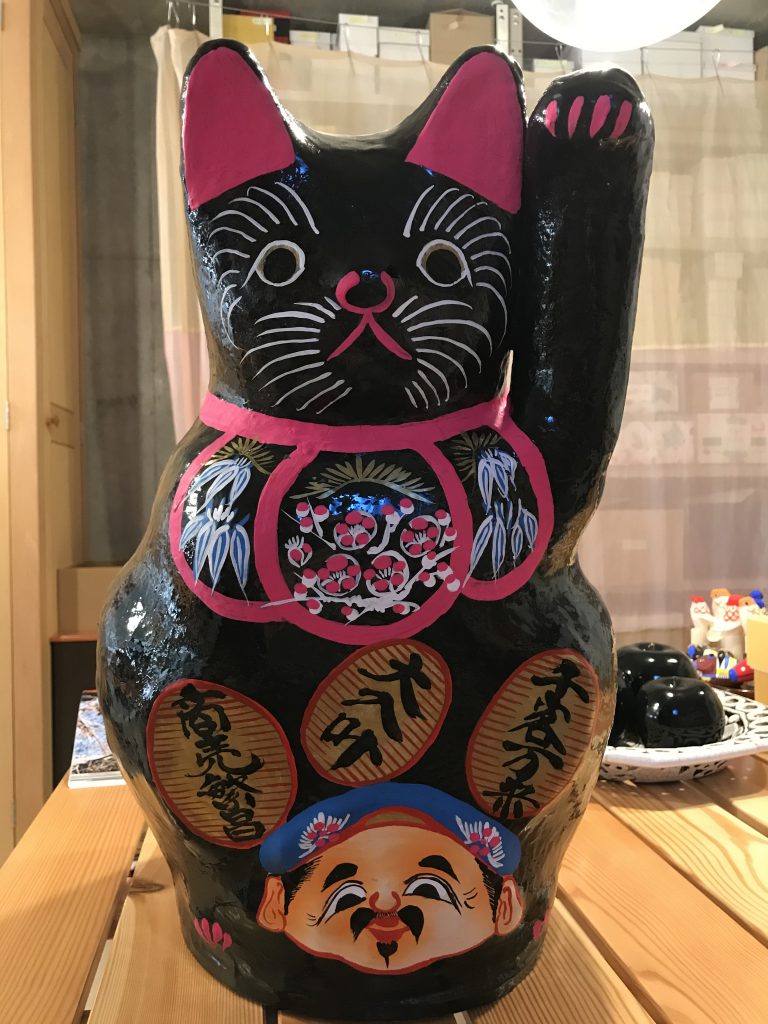
I realized that people making gangu in the northeast area of Japan might quit.
At first, I had black cats made so I could give them to my friends who wanted one because of this story. Then, the Great East Japan Earthquake happened. I think after the incident, everybody in Japan wondered what they could do. I realized that people making such objects in Tohoku [the northeast area of Japan] might quit. Luckily, one of my friends was from Fukushima City. I went to meet him there a month after the disaster. The situation was terrible. But my friend introduced me to Mr. Hashimoto, the most famous artisan making Miharu hariko dolls [papier-mâché dolls]. His family has been making them since the Edo period. There, I met a 93-year-old woman who was working and sticking washi paper. She told me she survived the earthquake by clinging to the cherry tree planted to celebrate when she got married. She also told me she had been making dolls for 80 years. It was that critical encounter that started everything. I wanted to do something for these artisans.
All the artisans kept telling me, ‘Why are you doing this? It won’t sell. You won’t make any money.’ But I think gangu are important and necessary for the precise reason that they are non-essential, that have no use in everyday life, do not sell a lot, and do not make money.
I also had another friend who was from Hamamatsu City in Shizuoka Prefecture. He took me to see Mrs. Nihashi, who was making Hamamatsu papier-mâché dolls. The lady was about 80 years old. Usually, such artisans continue their business from father to son. Still, for this workshop, the women are in charge, which is very rare. She was stressed with having too many orders, but she promised to produce some items for me when she would have time.
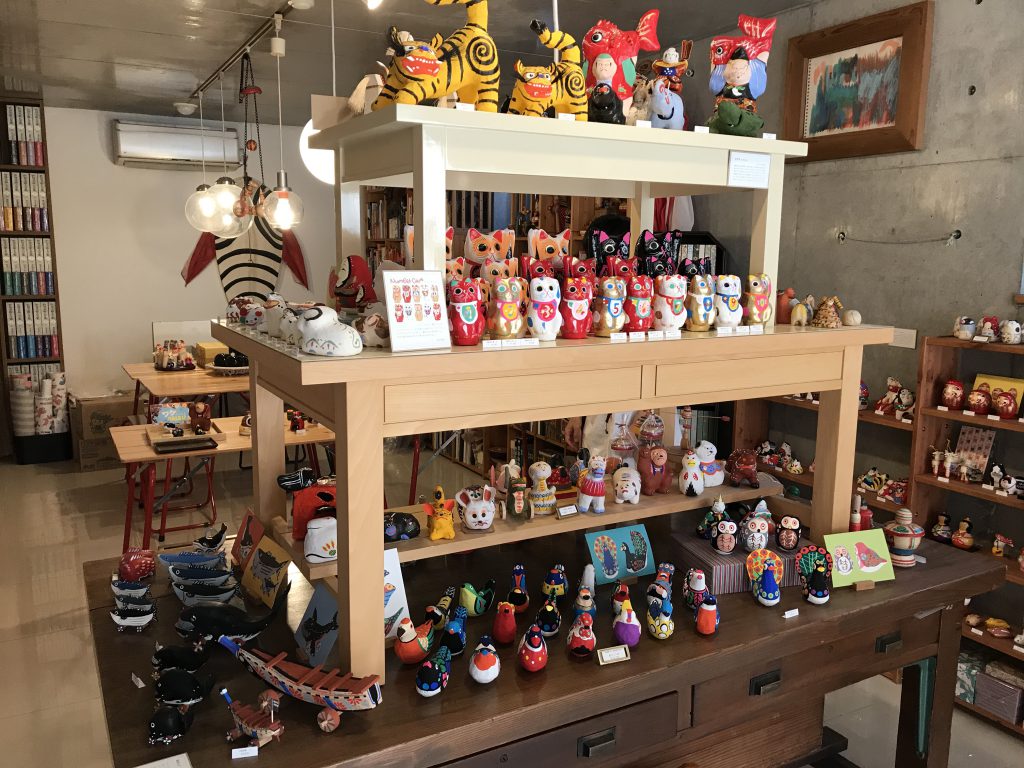
I believe that objects born from certain processes can hold a kind of power.
That’s how we got started. All the artisans kept telling me, “Why are you doing this? It won’t sell. You won’t make any money.” But I think gangu are important and necessary for the precise reason that they are non-essential, that have no use in everyday life, do not sell a lot, and do not make money. Let me tell you a moving story I heard from a famous artisan from Yamagata Prefecture to explain what I mean. He specializes in spinning tops and Kokeshi dolls.
One day, a person came and bought a small Kokeshi. A few days later, this person phones him and explains why they bought the doll. They had lost their home and were living in provisional housing. They were depressed and could not find the strength to do anything. They remembered that they used to have a Kokeshi doll near their television, and for some reason, they couldn’t help but want to buy one. Finally, after displaying the Kokeshi doll in their provisional lodging, they started to feel better. I believe that objects born from certain processes can hold this kind of power.
Mrs. Iijima: We often say that gangu are “lovable non-essential goods.” They’re not necessary in daily life, but they can affect a place’s atmosphere or people’s kokoro [heart, spirit].
Finding the Right Place for Your Gangu
What kind of customers visit your shop?
Mr. Usuda: We have Japanese customers who are regulars. For example, one of our customers is Sendai, who does research about gangu and buys something every time he comes by. We have a lot of foreign customers, too. We are about to move to Chofu City, but now our shop is located in Yoyogi-Uehara, which is quite popular among foreign visitors. Once, some women came into the shop and bought some things. After that, the numbers on our Instagram account suddenly became abnormally high. When I checked these people’s Instagram, they were designers from the Netherlands with many followers. After that, we had a lot more customers from Europe.
How do you choose the folkcraft toys you introduce in your shop?
Mr. Usuda: It’s entirely according to our personal senses. We don’t really care much about the name of the artisan who made it. What matters to us is if we think it is a suitable object or not.
Mrs. Iijima: Since we are designers, we have our own aesthetic sense, our style, and we choose objects that fit them.
Mr. Usuda: We also have our way to display them, especially regarding colors. Some time ago, someone from Time Out visited the shop to introduce it on their website. At first, they thought we were displaying modern things because they looked so pop and colorful.
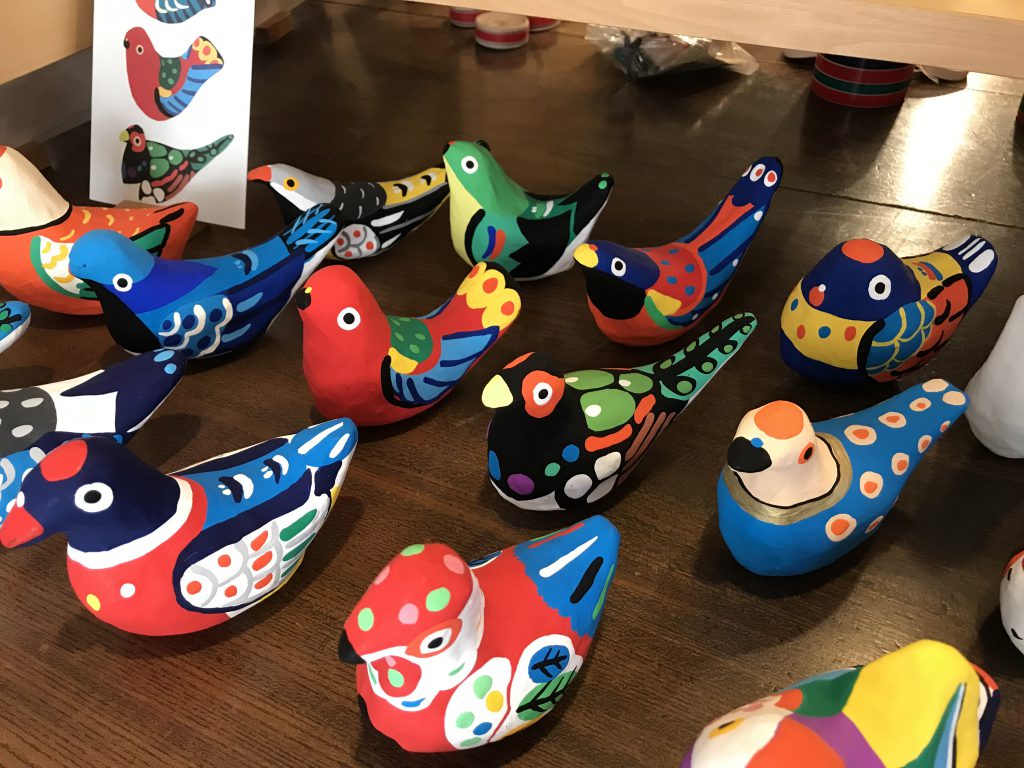
Do you have any advice on how to display such traditional items in modern housing?
Mr. Usuda: Until now, the people I know who are the best at displaying them are not Japanese, but my friends from Israel. They tend to show them as art objects. There’s no real technique to display them; it’s really a matter of personal aesthetic sense.
Mrs. Iijima: I think that what matters most is to have fun displaying it. Gangu are unique; they have a sort of humor to them. So, putting them in unexpected places will make them look fun and open new ways of seeing things. It’s essential to put your preconceptions aside and take it playfully.
Gangu are cute and humorful, but some of them are also a little bit scary.
Mr. Usuda: Objects really have the power to create an atmosphere, and children have a good sense of feeling where the objects should be. They put things instinctively. I think that keeping this sense is important.
Mrs. Iijima: Speaking of which, gangu are cute and humorful, but some are also a little bit scary. I think this is also very important. Children are very sensitive to it. Some time ago, we did a job for which we had to display traditional kites. There was a room full of them. My three-year-old daughter was so scared, she cried and refused to enter. Nowadays, Japanese children evolve in a clean, reassuring environment. Still, I believe that it can be useful for them to have the experience to feel what a scary place is like. Places like deep in the forest, or shrines with no one inside, places you feel you should not enter. Gangu can also play this role.
What you are saying reminds me of an interview I recently did with a Namahage from Tohoku. He told me the same. He believes that children nowadays should be granted access to a good scare.
Mrs. Iijima: Namahage are much scarier though [laughs]!
A Reflection of Their Maker
Gangu are interesting, but the artisans who make them are even more.
Can you show us your favorite gangu?
Mrs. Iijima: I love all of them [laughs].
Mr. Usuda: Let me show you a few ones.
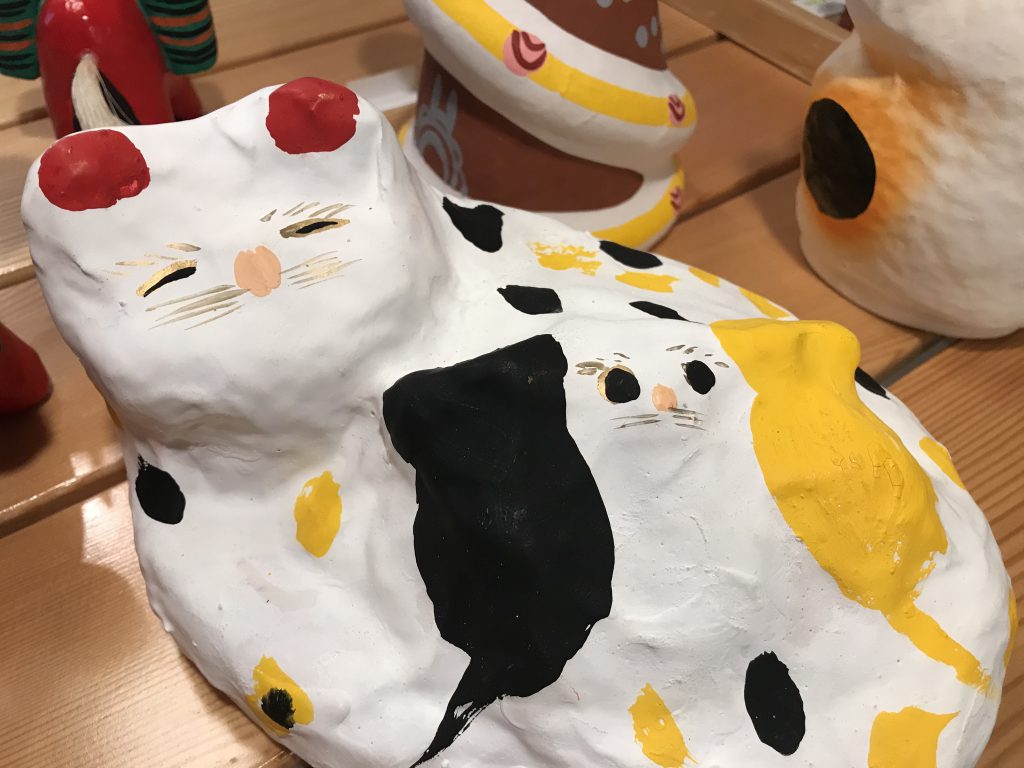
Actually, this one is not for sale. This is a Sawara hariko [papier-mâché doll from Sawara City], from Chiba Prefecture, made by Mr. Kamata. He’s famous for his cats. His creations were even featured on the cover of a book published in France. I had seen some of his cats with beautiful eyes wide open, and I ordered something similar, but when I received it, his eyes were closed [laughs]. I talked many times with this artisan. One day, he told me the reason he trusted me is that when I talk about gangu, I always say “kono hitotachi” [these people] and don’t refer to them as objects.
Mrs. Iijima: Gangu are interesting, but the artisans who make them are even more. They all have a strong character, and the story of their lives is directly linked to how they express themselves in their creations.
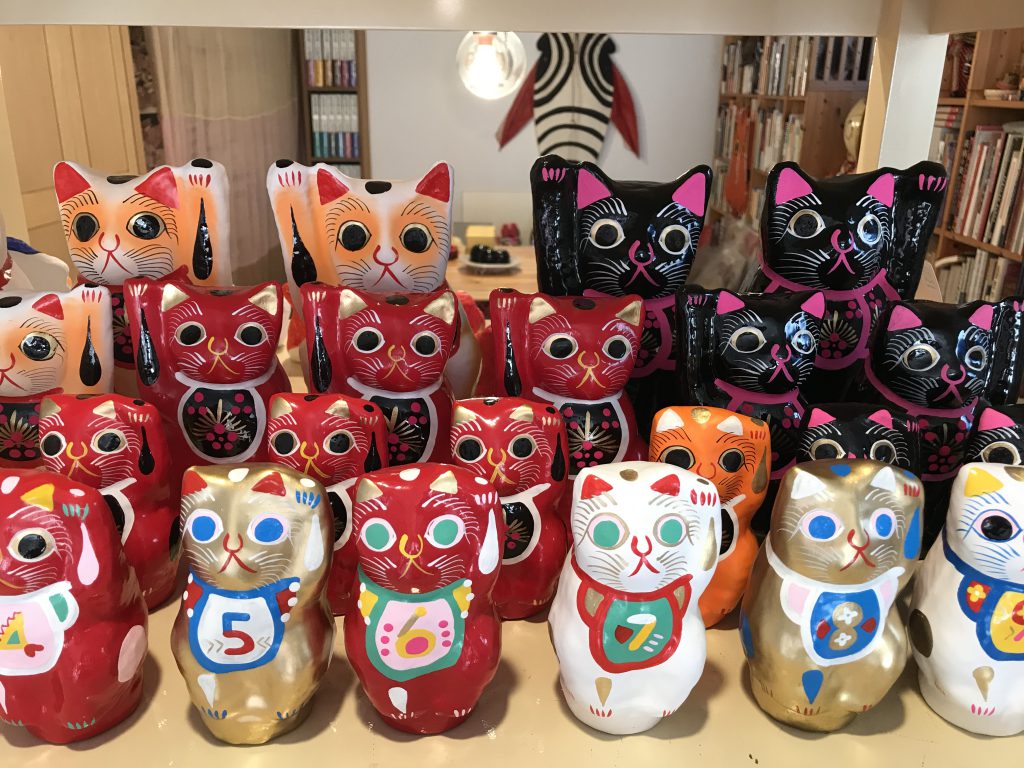
Mr. Usuda: This is our original black cat. Many people have told us that good things happened to them after they bought one. True story.
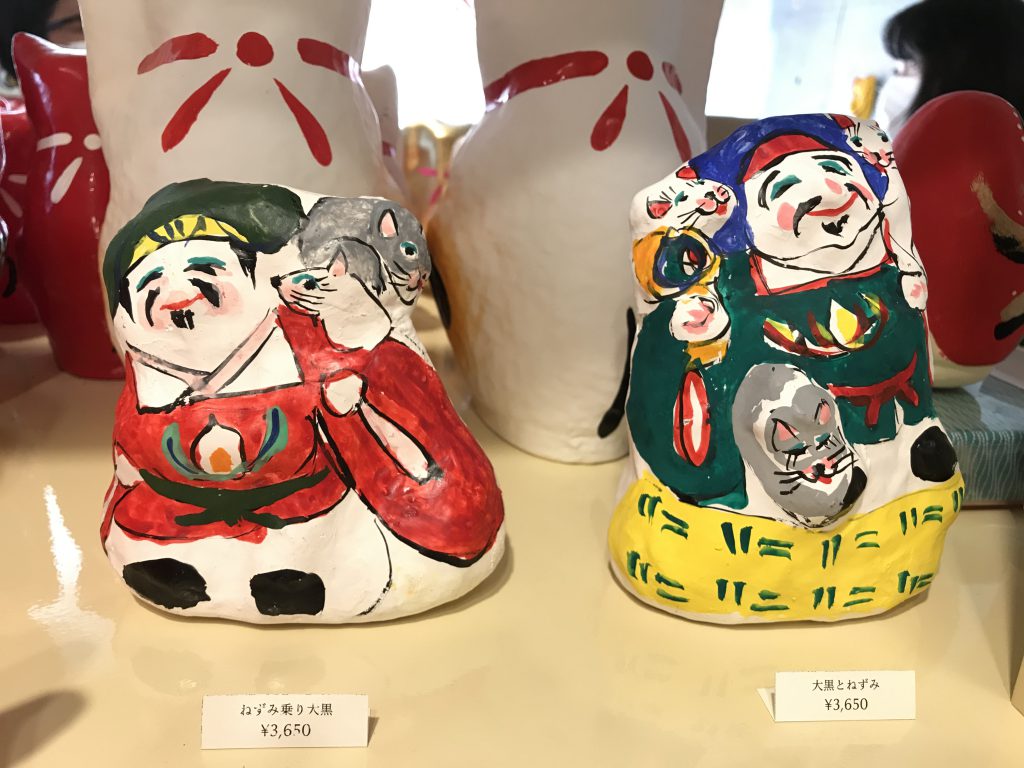
Mr. Usuda: Mr. Yoshioka made these Suma hariko. He always uses green eyeshadow on his characters [laughs]. Initially, he wanted to be a manga artist, and he also paints watercolors. That may explain why his gangu look relatively flat compared to others. He also paints the contours a lot. Another distinctive feature is that his gangu all have a different face. He’s also one of the rare artisans left to be using washi [traditional Japanese paper]. He says it’s easier to stick because it’s thin. He uses paper from old, damaged books from the Meiji era [1868–1912]! His gangu are my personal favorites. I will never get tired of looking at them. Also, I’m always excited to see his new creations. Last time, we got several Amabie [a legendary creature that is said to protect from plagues and became popular again during the Coronavirus pandemic]. They became a popular item.

Supporting a Disappearing Craftsmanship
Most artisans cannot make a living from making folkcraft toys only.
Earlier, you said many artisans told you gangu do not sell. How is the gangu artisans’ relationship with money?
Mr. Usuda: Most artisans cannot make a living from making folkcraft toys only.
Mrs. Iijima: Because of this, their children cannot choose to continue the family business, because they know they can’t make a living from it. I feel it’s also our role to encourage a price system matching the value of the artisans’ time and effort.
Mr. Usuda: We also sell postcards. The reason for that is that postcards can be produced in large quantities, as opposed to gangu, which take time to be created. We wish to do our best so that, someday, we can pay the artisans the royalties of the postcards’ design.
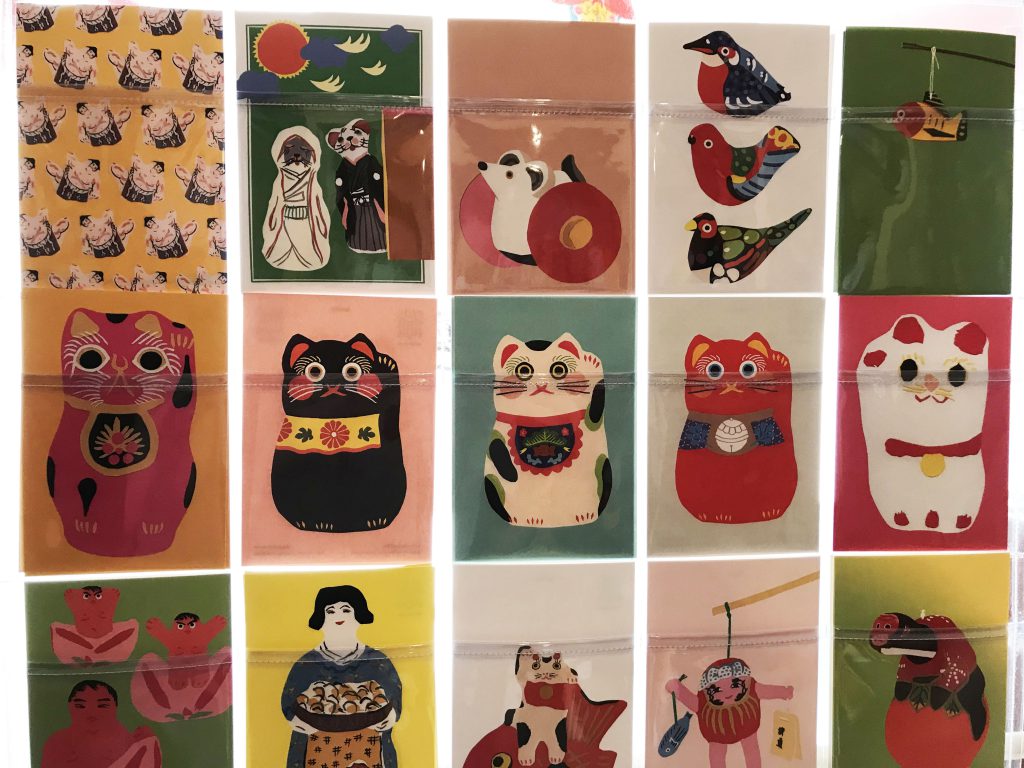
I was surprised that you also produce digital products like LINE stickers [LINE is the most popular messaging service in Japan] or patterns to use in the video game Animal Crossing!
Mrs. Iijima: I thought it would be an excellent opportunity to reach people who usually aren’t interested in gangu. Regarding the stickers, it associates Amabie and gangu. Because of the Coronavirus, people seem to have a renewed interest in spiritual things and lucky charms. I thought it was the right time for people to know about Japanese folkcraft toys. Since very recently, we are also producing t-shirts with an illustrator from England, who is a fan of our shop.
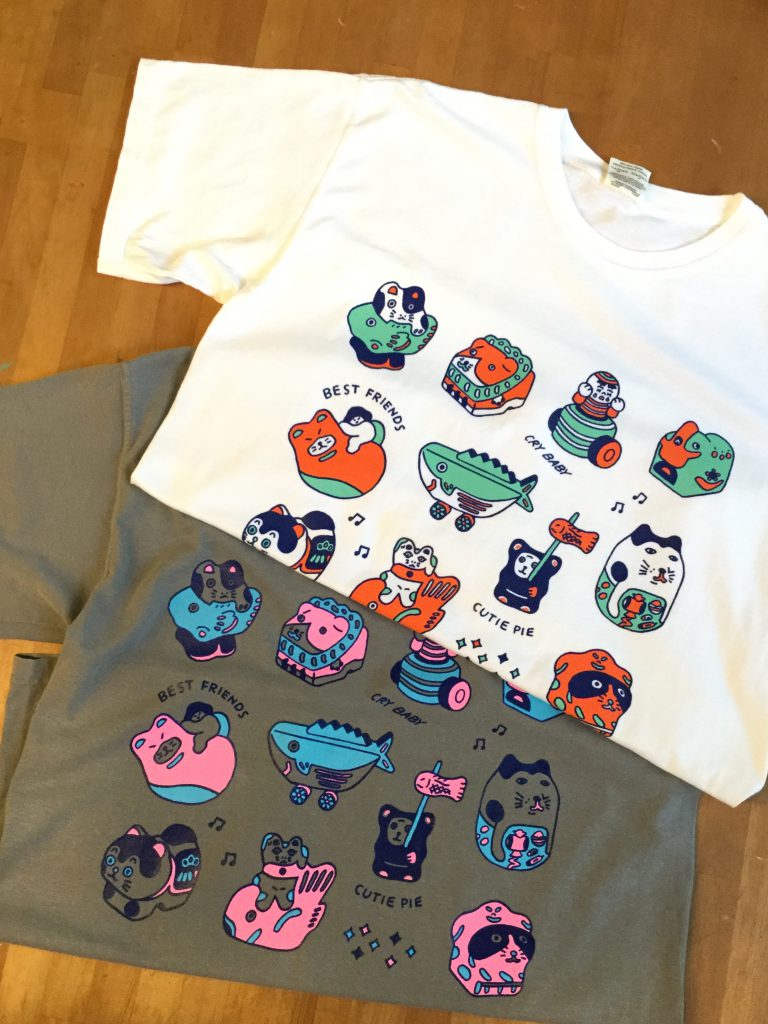
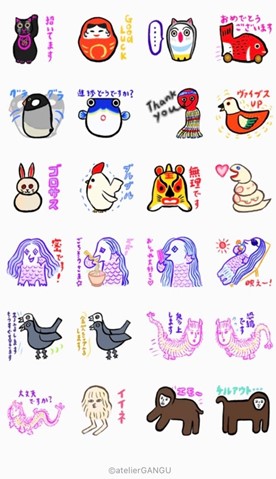
I believe that in the future, folkcraft toys can become a tool for promoting cultural diversity.
What are your objectives for the future?
Mr. Usuda: I would like to sell one million postcards. I would also like to help to revitalize the Japanese forestry and help the washi business. You can make great washi only if you have good quality soil and water. I’d like to rethink the production structure and how we can exchange resources with nature.
Mrs. Iijima: I believe that folkcraft toys can become a tool for promoting cultural diversity in the future. As we mentioned earlier, some Japanese gangu are born from cultural exchanges with China. There are interesting folkcraft toys all over the world, and to me, they embody the values of diversity. Each toy reflects the culture and context in which it has been created. I believe that people, especially children, can become more accepting of diversity by enjoying the toys’ differences and appreciating them as “lovable non-essential goods.”

Finding a New Home
After the interview, I could not help but purchase some gangu. Of course, after hearing the stories, I could not resist buying one mysterious black lucky cat (I’ll keep you posted if anything special happens to me in the next few weeks). I also purchased one of Mr. Yoshioka’s papier-mâché dolls. Coming back home, my problem was finding the right place to display them, because I have a passion for traditional Japanese items and there was not much free space left. Then, I remembered what Mrs. Iijima and Mr. Usuda said about being playful and following one’s instinct. After a few tries, this is where my gangu found its happy place:
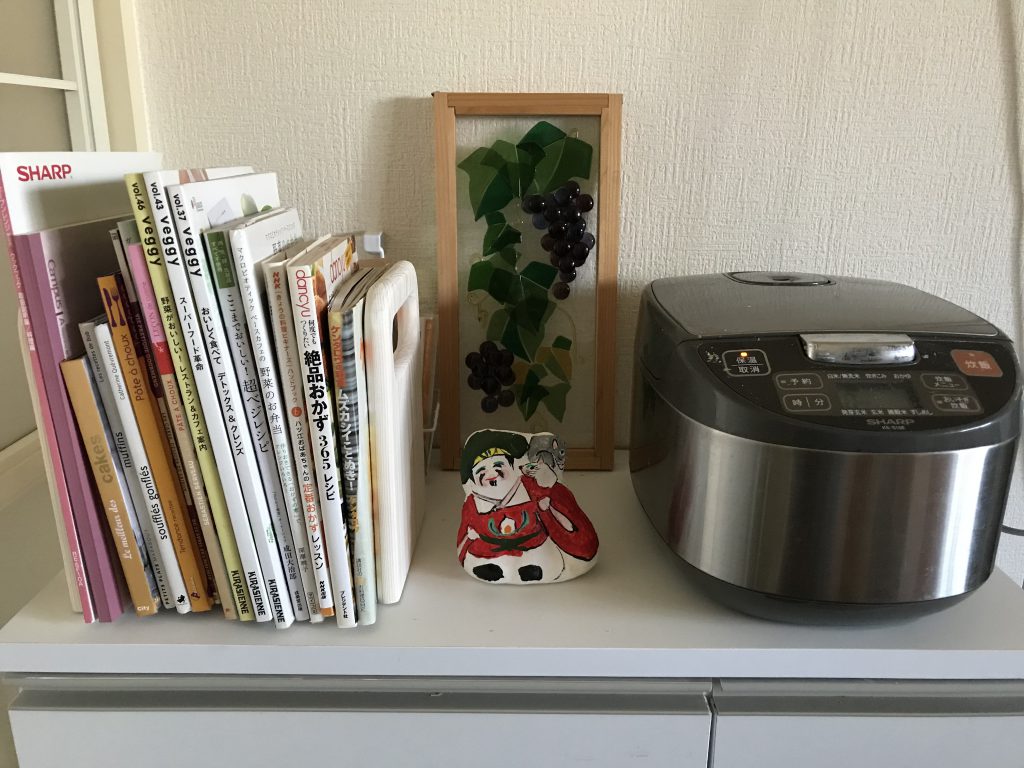
This folkcraft toy is a depiction of Daikokuten, one of the seven lucky gods who relates to rice, agriculture, and food. I guess that his being next to my rice cooker is not so strange after all.
Like after interviewing Nihonga painter Allan West, I couldn’t help but feel a bit sad at the perspective of an art dying because even the Japanese do not know it well. Maybe the cultural exchanges Mrs. Iijima was talking of are the key.
This article is not much, but I would be happy if it could raise an interest for Japanese folkcraft toys outside of Japan, and that some people will be charmed by these “lovable inessential items” as much as I now am.
If this article got you interested in gangu and you would like to support Japanese folkcraft toy artisans, Atelier Gangu has an online shop and they can ship internationally if you contact them first by email.

